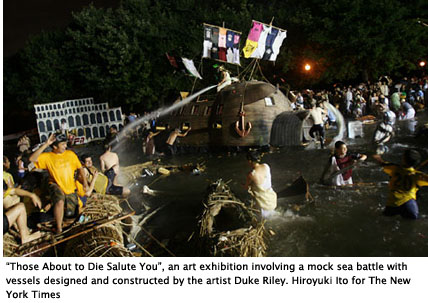In Queens, an Art Exhibition Gone Wild
By Libby Nelson
cityroom.blogs.nytimes.com
August 14, 2009

Sated with free beer and wine, and plenty of it, the toga-wearing crowd flung microwaved tomatoes and morsels of baguette into the Flushing Meadows-Corona Park reflecting pool in Queens.
“Boats!” they yelled. “Boats! Boats! Boats!”
This was an art exhibition “” a phrase that perhaps conjures a more subdued event. But the art, “Those About to Die Salute You,” involved moving humans, boats on water and those tomatoes. It was the creation of Duke Riley, whose work skews aquatic, fluid and unpredictable: He once built a wooden submarine, floated it too close to the Queen Mary 2, and was arrested.
Here was his vision for Queens on Thursday night: a Roman-style naval battle among representatives of New York museums. Teams from museums in four boroughs faced off, paddling in boats built from recycled materials like reeds and salvaged Styrofoam. They dressed in cardboard armor and painted their faces, wielding swords and shields.
At least, that was the general idea. There were no dress rehearsals; there was no script.
“I have no idea exactly what”™s going to go on,” Mr. Riley said before the performance. “There”™s a lot of variables and wild cards. I just hope everything goes smoothly and safely, and nobody gets too badly hurt.”
In the end, it was a sopping melee, very messy, and any visions of careful naval strategies quickly dissolved as the crowd let its enthusiasm run away with itself. But it was art. And nobody got too badly hurt.
The idea evolved over the course of a year, Mr. Riley said. He had been thinking for some time about naumachia, battles staged in flooded coliseums to entertain ancient Romans. When he was asked to do an exhibition for the Queens Museum of Art, which hosted the event, “everything just kind of clicked,” he said.
By Thursday afternoon, the reflecting pool was filled with 70,000 gallons of water for the first time since the 1964 World”™s Fair. The teams, from the Queens Museum of Art, the Brooklyn Museum, the Bronx Museum of the Arts and El Museo del Barrio in Manhattan, were putting on their war paint and cardboard armor. A museum intern had spent the day microwaving tomatoes, seeking to achieve the perfect consistency for throwing.
“It”™s one of these things where you”™re taking a certain degree of risk with a battle like this,” said Tom Finkelpearl, executive director of the Queens Museum of Art.
At the museum on Thursday night, wine and beer were flowing. Toga-wearing guests packed thigh-to-thigh were shouting over the rock band playing behind them. The party started just past the sign that stated, “No Food or Drink Beyond This Point.”
Spectators moved to the reflecting pool, sitting quietly at first. As the wait stretched to an hour, they grew restless. The tomatoes, in boxes waiting for the performance, proved too much of a temptation, and soon people on the two sides of the reflecting pool were throwing the microwaved tomatoes back and forth. A few onlookers unfurled umbrellas to protect themselves.
Then the audience began jumping into the pool as the Queens Museum of Art boat emerged. An announcer grabbed the microphone: “Let”™s get it started!” he said.
But that ship, as they say, had sailed.
“Get out of the pool! Get out of the water!” he yelled, trying to regain order and using several expletives. “We”™re not starting till you”™re out of the pool!”
The ensuing battle resulted in the disintegration of most of the boats. The audience refused to stay corralled, jumping in the water to hurl tomatoes and climb onto the boats. A giant pig-shaped boat, representing Manhattan, emerged mostly unscathed. The Queens boat collapsed completely. The Brooklyn boat, a battleship, disintegrated. The Staten Island Ferry made an appearance.
The Queen Mary 2, Mr. Riley”™s old target, was the last to emerge, and it was promptly set aflame, driving the spectators from the water. Then Roman candles began spitting, followed by fireworks. Some burst overhead; others seemed to land almost a little too close, and the audience ducked. The flames reached almost three feet high before the boat was tipped into the water and the fire extinguished.
“You never really know what”™s going to happen,” Mr. Riley said after the performance. “Nobody got hurt, and I”™m not in jail.”
Afterward, the audience appeared enthused but slightly shell-shocked. Some praised the participatory nature of the art; others were still recovering from the fireworks.
“It was radical, super radical,” said Catherine Harine Connell of Brooklyn. “The fact that it was in a public park in Queens. “¦ It was free form, but still organized.”
Ms. Connell was euphoric; others were alarmed.
“That was wilder than I ever would have expected,” said Dorothy Trojanowski, who added that the event was “out of control.”
“The danger factor was,” she said, pausing, “stimulating.”
As everyone piled out of the pool, leaving debris from the boats behind, an announcer promised a Roman orgy at the museum afterward.
Given the night”™s events, he might have been serious.
